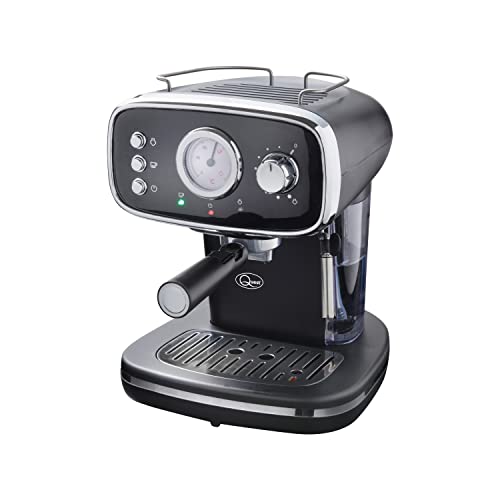How to Maintain Espresso Machines
Companies like car dealerships, hair salons and doctor's office can benefit from offering espresso drinks. The availability of these delicious drinks can improve customers' patience as they wait for service and enhance the atmosphere of your establishment.
This unique machine, which was a Good Housekeeping 2022 Espresso winner utilizes smart dosing to measure and distribute the right amount of coffee ground for each shot. It also has a milk froth that performed well in our tests.
The Basics
Espresso machines are a great addition for any home or office. They can be used to make many different drinks, like cappuccinos or lattes. They work by forcing hot water through ground coffee under pressure. This results in an intense shot of coffee that is very tasty. It also has a significant concentration of caffeine, which is a potent stimulant.
They are available in a broad range of sizes, from compact models for home use to larger ones for commercial purposes. These machines are available in manual and semi-automatic versions. Semi-automatic models have an integrated pump that controls the flow and pressure of water. Manual machines require you to manage this manually. Some semi-automatic machines have grinders, whereas others don't. The type of machine that you select will depend on your budget and personal preferences.
The manual espresso machine operates by turning a handle, which pushes water through grounds in the filter basket. This kind of machine, also known as a caffettiera or macchinetta is the most well-known type of espresso maker. It has an under-chamber that holds the water, and a top chamber that has the filter made of metal. When it is heated the steam from the water is forced through the grounds, and finally into the top chamber. This is where the espresso is ready to serve.
Varieties
Depending on your needs You can pick from a range of espresso machines. They include semi-automatic, automatic, manual and fully automatic coffee machines. Each machine has its own unique method of making espresso shots and other drinks like cappuccinos and lattes.
The first machines weren't fully automated. They required the user to manipulate the lever to produce the pressure needed to pull one shot. These machines are still available however they are not as widespread due to the work required and the stress they can cause. Modern espresso machines utilize a variety of mechanisms to create pressure such as screw, push and see-saw designs. This allows users to manage pre-infusion, water volume and pressure more precisely than with lever machines.
A pump-driven espresso machine is similar to the moka pot on the stove, but uses an electric pump instead of steam to press the grounds. They have a boiler which is heated to a point of boiling, and then a pump presses it through a group head into the coffee. These are the most popular kinds of espresso machines, and are generally less costly than other models.

Semi-automatic espresso machine combine the best characteristics of manual and pump-driven espresso machines. They allow you to grind the beans and tamp them, however a motor regulates the pressure for consistency. They also have a separate chamber that is heated and froths milk and some have an integrated grinder.
Functions
Commercial espresso machines can make a broad variety of coffees, such as espressos at the press of one button. They use pre-packaged coffee pods that have been precisely dosed and packaged to make one cup of coffee or espresso. These machines are extremely popular in offices that are busy because they eliminate the requirement for a grinding machine for dosing, tamping, and grinding. However, since they also lack steam functions, you'll need a separate milk frother to make cappuccinos and lattes.
In the 19th century a large number of cafes in Europe relied on steam machines to speed up brewing and boost production. The early machines were heated with an open flame, which resulted in unbalanced pressure and temperature. Inventor Angelo Moriondo of Turin, Italy is credited with creating the first machine that was capable of making espresso without using steam.
The most common type of espresso machine today is a pump-driven system. They are equipped with a porta-filter into which ground espresso beans are inserted. When the valve is set to the espresso position where the espresso is extracted by water under 15 atmospheres of pressure from an heating vessel. After uk espresso machine is complete, the portafilter is removed and emptied in order to be cleaned.
Automated espresso machines are semi-automatic systems, controlling the extraction time based upon internal or volumetric timers. They also eliminate the barista's ability to tamp or grind coffee, which can affect the quality of the final product.
Maintenance
Espresso machines aren't the most glamorous item in the coffee shop, but they are incredibly important. How you maintain the espresso machine will impact the quality and taste of your drinks.
A clean espresso machine ensures that the flavor of your coffee won't be compromised and your customers will enjoy a pleasant experience. Regularly scheduled cleanings can extend the lifespan of your espresso machine.
Clean the portafilter as well as the baskets at every shift, using a damp, clean cloth to remove any residue and oils left behind. In this process, backflush the gasket of the portafilter (the seal between the portafilter's seal and the group head) by inserting a brush made of nylon into the gasket and moving it around to loosen any buildup. Rinse the gasket with water and then run it through until the water is clear.
Every week or as needed mix espresso machine cleaner in the container of water, following the instructions of the manufacturer. Then soak the baskets and portafilters in the cleaning solution for a night. If your espresso machine is equipped with steam wands, you can remove the wand and screen from the collection using the help of a screwdriver, and soak them separately in the cleaning solution.
